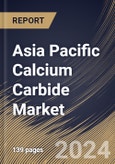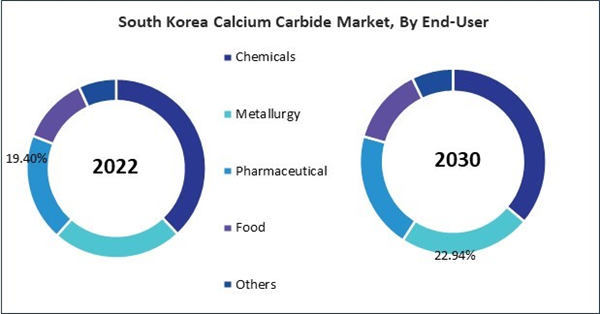Calcium carbide finds diverse applications in the chemical industry across various end-user segments. One significant application is in the production of acetylene gas, used as a raw material in the synthesis of numerous organic chemicals, including vinyl chloride monomer (VCM) for PVC production and various solvents and plastics. Thus, The South Korea market consumed 1,156.09 kilo tonnes, calcium carbide in 2022.
The China market dominated the Asia Pacific Calcium Carbide Market, by Country in 2022, and would continue to be a dominant market till 2030; thereby, achieving a market value of $4,025.6 Million by 2030. The Japan market would showcase a CAGR of 4.6% during (2023 - 2030). Additionally, The India market is registering a CAGR of 5.3% during (2023 - 2030).
Calcium carbide is a chemical compound composed of calcium and carbon, with the chemical formula CaC2. It is a grayish-black crystalline solid that reacts with water to produce acetylene gas. It is used in various industrial applications, including welding and metal cutting.
Moreover, it is also used in the production of various chemicals, such as polyvinyl chloride (PVC) and calcium cyanamide, and in the ripening of fruits. Additionally, it has been historically used in carbide lamps for illumination.
Finished steel imports and exports totaled 6.02 MT and 6.7 MT, respectively, in FY23. India exported 11.14 MT of finished steel in FY22. As of November 2023, the value of imported finished steel was 7.82 LMT, compared to exports of 2.34 LMT. As of November 2023, the export and import volumes of finished steel for the fiscal year FY24 were 4.03 MT and 4.25 MT, respectively. Domestic supply of raw materials, including iron ore, and cost-effective labor have been the primary drivers of the expansion of the Indian steel industry.
Based on End-User, the market is segmented into Chemicals, Metallurgy, Pharmaceutical, Food, and Others. Based on Application, the market is segmented into Acetylene Gas, Calcium Cyanamide, Reducing & Dehydrating Agent, Desulfurizing & Deoxidizing Agent, and Others. Based on countries, the market is segmented into China, Japan, India, South Korea, Singapore, Malaysia, and Rest of Asia Pacific.
List of Key Companies Profiled
- American Elements
- Denka Company Limited
- Merck KGaA
- Thermo Fisher Scientific, Inc.
- Santa Cruz Biotechnology, Inc.
- Lonza Group Ltd.
- Nippon Carbide Industries Co., Inc.
- DCM Shriram Ltd.
- Chemford International
- Alzchem Group AG
Market Report Segmentation
By End-User (Volume, Kilo Tonnes, USD Billion, 2019-2030)- Chemicals
- Metallurgy
- Pharmaceutical
- Food
- Others
- Acetylene Gas
- Calcium Cyanamide
- Reducing & Dehydrating Agent
- Desulfurizing & Deoxidizing Agent
- Others
- China
- Japan
- India
- South Korea
- Singapore
- Malaysia
- Rest of Asia Pacific
Table of Contents
Companies Mentioned
- American Elements
- Denka Company Limited
- Merck KGaA
- Thermo Fisher Scientific, Inc.
- Santa Cruz Biotechnology, Inc.
- Lonza Group Ltd.
- Nippon Carbide Industries Co., Inc.
- DCM Shriram Ltd.
- Chemford International
- Alzchem Group AG
Methodology

LOADING...









